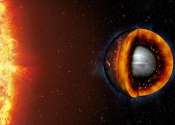Liquifying a rocky exoplanet
Rocky exoplanets that are around Earth-size are comparatively small, which makes them incredibly difficult to detect and characterise using telescopes. What are the optimal conditions to find such small planets that linger ...









